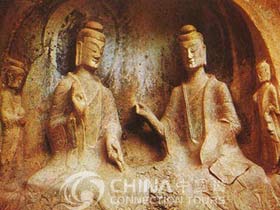 The Bingling Grottoes, also known as the Bingling Temple, are a series of Buddhist caves that are situated on a not easily accessible cliff face, some 80km from Lanzhou. At some point the caves were named the Thousand Buddha Caves, despite the fact that there have never been more than 200 grottoes. The first cave was built here in 420 AD, by daring Buddhists who descended from the cliff on ropes to carve their masterpieces. Although the cave complex was enlarged gradually over many centuries, it is the work of both the Song (960-1279 AD) and the Ming (1368-1644 AD) Dynasties that remains most impressive. The temple was, in-between these golden years, to become a Tibetan Monastery (in the Yuan Dynasty, 1271-1368 AD). Within and on the cliff are a series of winding walkways and stairs that will lead you around the site. The caves, carved out of the cliff's porous stone, contain over 700 statues, of both clay and porous rock, and hundreds of frescoes. Of the statues, the largest is a giant 27 meter-high seated Maitreya, the future Buddha, and the smallest is a miniscule 25 centimeters. It is the lower caves that are the most impressive. Cave 169 is considered to be one of China's oldest grottoes, housing a faded Buddha and 2 Bodhisattvas. This cave, in an area of 200 square meters, also holds the earliest epigraph of any of China's caves.
The Bingling Grottoes, also known as the Bingling Temple, are a series of Buddhist caves that are situated on a not easily accessible cliff face, some 80km from Lanzhou. At some point the caves were named the Thousand Buddha Caves, despite the fact that there have never been more than 200 grottoes. The first cave was built here in 420 AD, by daring Buddhists who descended from the cliff on ropes to carve their masterpieces. Although the cave complex was enlarged gradually over many centuries, it is the work of both the Song (960-1279 AD) and the Ming (1368-1644 AD) Dynasties that remains most impressive. The temple was, in-between these golden years, to become a Tibetan Monastery (in the Yuan Dynasty, 1271-1368 AD). Within and on the cliff are a series of winding walkways and stairs that will lead you around the site. The caves, carved out of the cliff's porous stone, contain over 700 statues, of both clay and porous rock, and hundreds of frescoes. Of the statues, the largest is a giant 27 meter-high seated Maitreya, the future Buddha, and the smallest is a miniscule 25 centimeters. It is the lower caves that are the most impressive. Cave 169 is considered to be one of China's oldest grottoes, housing a faded Buddha and 2 Bodhisattvas. This cave, in an area of 200 square meters, also holds the earliest epigraph of any of China's caves.

